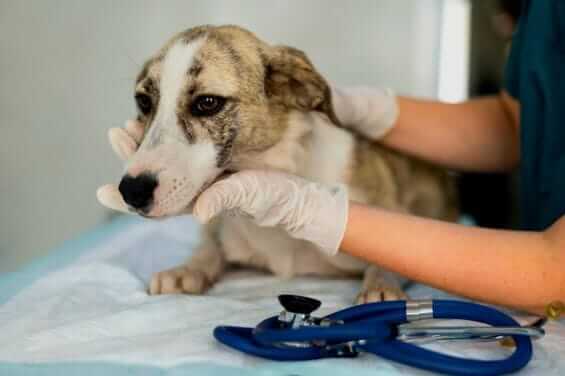What Are Hot Spots In Dogs?
Hot spots, medically known as acute moist dermatitis or pyotraumatic dermatitis, are irritated, red, inflamed, and often painful lesions that can develop rapidly on a dog’s skin and cause discomfort. This is a prevalent skin condition in dogs that affects dogs of all breeds and all ages. These lesions mostly appear as small red spots that grow very rapidly within hours and become large inflamed spots that ooze and sometimes contain pus. Hot spots can appear on almost all parts of the body but they are mostly seen on the head, limbs, and hips.
What Does A Hot Spot Look Like?
Hot spot appear as a irritated, red, inflamed lesion on the surface of dog’s skin. These lesion are mostly filled with pus and sometime ooze. Hot spots are commonly seen on head, legs, and hips of a dog.

What Are The Causes Of Hot Spots In Dogs?
Hotspots develop due to several reasons because there are many things that trigger itching such as
1- Behavioral licking:
Some dogs love to lick or scratch different parts of their bodies such as legs or neck. The excessive licking triggers an itch. Hot spots generally develop as a result of self-inflicted trauma that is caused by excessive licking, chewing, or scratching of a particular area of the skin due to itching. This self-inflicted trauma causes more itching and irritation and as a result, dogs scratch that area even more. This itching starts the cycle of itching, licking, and scratching which worsens the condition.
2- Allergies:
In most cases, different allergies in dogs trigger the itching and start the cycle of itching and scratching. Dogs can develop allergies to various substances such as pollen, dust mites, certain foods, or environmental allergens. These allergic reactions cause skin irritation and itching, which pushes the dog to scratch that area vigorously and worsens the problem.
3- Parasites:
Fleas ( i.e Ctenocephalides canis or Curtis), ticks ( i.e Dermacentor variabilis), and mites (i.e Sarcoptes scabiei, Otodectes cynotis, or Demodex canis) are common parasites that can infest a dog’s skin. These parasites cause infection that results in intense itching and irritation. Constant scratching and biting at specific places irritates the skin and it results in the formation of hot spots.
4- Skin Infections:
Bacterial or fungal infections can also contribute to the formation of hot spots. Moisture, warmth, and damaged skin provide an ideal breeding ground for bacteria and fungi, that cause inflammation and skin lesions.
5- Moisture or Matting:
Dogs with matted hairs, especially those who love to swim, are at high risk of developing hot spots. Moisture stays in the area of matted hair. Moisture is an ideal place for infection-causing bacteria to grow. The same thing happens with dogs with thick double coats or wiry coats. These coats do not dry completely after a bath or swim session which makes lesions on the skin because moist places are the houses for the bacteria or fungi.
6- Underlying Health Conditions:
Certain underlying health issues such as hormonal imbalances, autoimmune disorders, or skin diseases like atopic dermatitis can put dogs at risk of developing hot spots.
What Are The Symptoms Of Hot Spots In Dogs?
It’s extremely essential to identify whether a dog has hotspots or other skin conditions to address proper solutions and further issues. Common signs and symptoms of hot spots include:
- Red, inflamed, and moist lesions on the skin
- Intense itching or licking at a specific area
- Presence of pus or discharge
- A foul smell emerged from the affected area
- Hair loss around the lesion
- Pain or discomfort when touched or scratched
What Dog Breeds Are More Prone To Hot Spots?
Dogs that have thick double coats or wiry coats are at higher risk of developing hotspots than dogs with single coats. The dogs that are prone to hot spots are:
- Golden Retrievers
- Labrador Retrievers
- German Shepherds
- Saint Bernards
- Newfoundland
What Are Treatment Options for Hotspots In Dogs?
Treatment for hot spots focuses on relieving inflammation and pain, controlling itching, preventing infection, and promoting healing. The first step in treating hot spots is to trim the hair around the affected area to allow better air circulation and prevent further moisture buildup. Gently clean the affected area with a mild antiseptic solution to remove debris and bacteria. There are a lot medicines present out there to treat all the underlying causes that set off itching. Here is list of some treatments for many underlying issues.
Treatment for hotspots due to Allergies:
If the cause of itching is Allergies vet may prescribe some anti-allergic medicines such as Diphenhydramine (Benadryl), Cetirizine (Zyrtec), Fexofenadine (Allegra) or some Topical ointments such as Hydrocortisone cream, Calamine lotion.
Treatment for hotspots due to Ticks, Fleas, or Mites:
If hot spots are formed due to insect bites such as Fleas, Ticks, or Mites then some topical flea/tick preventatives such as Fipronil (Frontline) or Imidacloprid (Advantage) are given.
Your vet may provide some Oral flea/tick control medication such as Comfortis, (Bravecto) or antibiotics (Cephalexin, Clindamycin) to treat secondary infections.
Treatment for hotspots due to Bacterial or Fungal infections:
If itching is triggered by Bacterial or Fungal Infections then some Antibiotics such as Amoxicillin, Cephalexin or Antifungals such as Ketoconazole, Fluconazole are given to treat bacterial or fungal infection.
Tick removing Medicated shampoos such as Chlorhexidine shampoo or Ketoconazole shampoo help to kill all the insects on dog’s skin.
Treatment for hotspots due to self-inflicted trauma:
If the reason behind the formation of hot spots is behavioural licking, your vet may prescribe anti-allergic and anti-inflammatory medicine to treat the problem. He may recommend to use an Elizabethan collar or a muzzle to prevent further self-inflicted trauma.


| Veterinarians usually prescribe these drugs based on the pet’s specific needs as well as the underlying reason for the hotspots. To guarantee a secure and effective procedure for treatment, it’s imperative to adhere to the veterinarian’s dose and administration recommendations. |
How to Prevent Hot Spots In Dogs?
Though certain dogs may have underlying conditions that make them more likely to develop hot spots, there are a few precautions you may take to reduce the risk:
- Prevent matting, which can trap moisture and allergens against the skin, by keeping your dog’s coat neat and tidy.
- Take the proper precautions to shield your dog from infestations of fleas, ticks, and mites.
- Identify and avoid potential allergens that trigger allergic reactions in your dog. Consult with your veterinarian to develop an allergy management plan if necessary.
- Feed your dog a healthy, well-balanced meal to help with his immune system and general well-being.
- Make an appointment for routine examinations with your veterinarian in order to identify and treat any underlying medical conditions as soon as possible.
FAQs About Hot Spots In Dogs
The healing time for hotspots in dogs can vary depending on the underlying reason, intensity of the infection, and treatment provided. The speed of recovery also depends on the immunity of the dog. While more serious cases can take several weeks to fully heal, moderate cases may improve with treatments in 4 to 7 days.
Although hotspots themselves usually aren’t considered a serious risk to a dog’s life, they can cause problems like secondary bacterial infections or extreme skin irritation if they are not treated appropriately. In order to avoid potential complications and to facilitate the healing process, immediate veterinary care is essential.
Hotspots are not contagious between dogs. They are localized skin irritations resulting from a number of conditions such as allergies, parasites, and skin infections. However, if the underlying reason for hotspots is transferable (e.g., some bacterial or fungal infections), it is crucial to prevent transmission to other pets or humans.
Hotspots can sometimes heal on their own with appropriate wound care and hygiene. But mostly hotspots do not completely heal and can get worse or come back over time if the underlying cause is not treated appropriately. To effectively manage and avoid hotspots, it is advised to seek veterinary guidance and treatment.
Follow the vet’s guidance about medications and monitor the healing process of your dog. Do not attempt to stop treatment without your veterinarian’s permission even if the hot spot’s visible symptoms are better until the affected area is completely healed. It reduces the risks of recurrence of infection.
If you observe any symptoms of infection, increased inflammation, or no improvement after treatment, consult with your veterinarian for further treatment and modification in medication. Most hotspot areas can heal with appropriate care and attention in a fairly short period of time, allowing your dog to comfortably enjoy normal activities.
Home remedies can help treat all those puss-filled lesions to a greater extent. Here are some home remedies that can help to relieve hotspots.
1- Cool Compress: First of all, clean the affected area completely with lukewarm water or antiseptic solution. After cleaning pat dry that area with a clean towel or a paper towel. Apply a cool compress to the affected area. It helps relieve itching and inflammation. Use a clean cloth soaked in cool water and gently apply it to the hot spot for 5-10 minutes several times a day.
2- Apple Cider Vinegar: Mix raw, unfiltered apple cider vinegar with water (1:1). Use a cotton ball or spray bottle to apply it to the hot spot. Apple cider vinegar has antimicrobial properties that may help prevent infection and promote healing. Do not use undiluted Apple cider vinegar, as it can be too harsh and may sting.
3- Aloe Vera Gel: Apply a small amount of pure aloe vera gel directly to the hot spot. Aloe vera helps soothe itching and inflammation. Make sure to use aloe vera gel specifically formulated for pets or check with your veterinarian before using it, as some formulations may contain ingredients that are toxic to dogs.
4- Oatmeal Bath: Prepare a soothing oatmeal bath by blending plain, uncooked oatmeal into a fine powder and mixing it with warm water to form a paste. Apply the oatmeal paste to the hot spot and allow it to sit for 10-15 minutes before rinsing thoroughly with lukewarm water. Oatmeal has anti-inflammatory properties that help to soothe skin.
5- Coconut Oil: Coconut oil is very effective remedy for hot spots because Coconut oil has moisturizing and antimicrobial properties that can help soothe irritated skin and prevent infection. Gently massage a small amount of coconut oil onto the hot spot and allow it to absorb.
6- Proper Hygiene: Keep the affected area clean and dry to prevent further irritation and promote healing. Avoid using harsh soaps or shampoos that may exacerbate the condition.
For mild cases of hot spots, home remedies can help with the process of recovery and offer short-term relief. However, it’s important to speak with your veterinarian before starting any treatment to be sure it’s right for your dog’s particular condition. Furthermore, frequent or severe hot spots on your dog may be a sign of an underlying medical condition that needs to be examined and managed by a professional.





